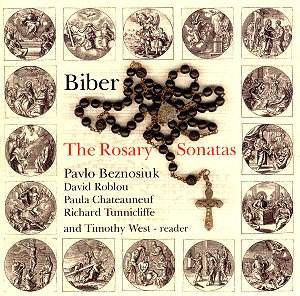The fifteen Mystery
Sonatas date from approximately 1674
and are works of the utmost spirituality.
Biber wrote them - he was himself a
virtuoso violinist and a technical innovator
not least in his use of scordatura,
a retuning of the violin
from the standard fifths - as
representative of moments in the lives
of Christ and the Virgin Mary. They
are pictorial and not obviously representational.
The Mysteries are presented sequentially
– the five Joyful mysteries followed
by the five Sorrowful Mysteries and
finally the five Glorious Mysteries
– and ending, properly speaking, with
the great unaccompanied Passacaglia
(as here). In the extraordinary manuscript
of the Sonatas, housed in the Bavarian
State Library, there are fifteen engravings
(probably taken from a Rosary Psalter)
depicting the fifteen mysteries whilst
the concluding Passacaglia has an engraving
of a Guardian Angel holding a child’s
hand. In this recording Timothy West
prefaces each sonata as he reads from
3 Rosary Psalters.
Pavlo Beznosiuk has
been associated with Biber’s Rosary
Sonatas for a number of years now and
his performances are invariably eagerly
anticipated. Surrounding him is an experienced
accompanying group, like-minded and
expressive, creating textures of great
depth with theorbo, archlute, viola
da gamba and violone as well as harpsichord
and chamber organ. Beznosiuk evokes
the tension and ascending lines, full
of the purest expectation, in the Annunciation
and finds grandeur and nobility in the
Allemanda of the second sonata, the
Visitation. Equally open to the expressive
tenderness and delicacy of the Nativity
(an especially well voiced Courante/Double)
he impressed me especially strongly
in the swaying and crispness and colourful
attacca style, full of edge, in the
Ciacona of The Presentation in The Temple.
The aptness of that instrumental group,
for example, can be exemplified by the
archlute in the Sixth Sonata. Beznosiuk
is fine at the communing intimacies
that course through the Sonatas (the
first Adagio of the Sixth, say) or in
the acrobatic leaps of the Ninth or
the same sonata’s tentative frailty
and final, abrupt ending.
The searing Crucifixion
is followed by a Resurrection conjoined
with drone and imitative writing, coupled
with spare, elliptical drama and an
emergent Hodie Hymnal of devastating
candour. But Biber manages to vest these
sonatas with rustic brio as well (see
the Intrada of No.12) as much as the
increasing exultation of the Descent
of the Holy Ghost and the Assumption,
ending in the noble lyricism (well played
by Beznosiuk) of the Sarabanda of the
Fifteenth. The great Passacaglia tends
to heighten a perception that only once
or twice had impinged, namely that Beznosiuk
sees the ebb and flow of its rhetoric
as intensely human and as a result susceptible
of some metrical daring. He doesn’t
take it as an unwavering Passacaglia
arch, tending rather to coil and uncoil
with fervour, if sometimes threatening
the structure. A modern instrument performance,
such as that by the Czech violinist
Gabriela Demeterova takes an opposite
view – and it’s one I share, but there’s
no denying Beznosiuk’s understanding.
There are plenty of
competitors in the repertoire, from
such as Demeterova (Supraphon) and original
instrument performances from such well-known
musicians as Holloway and Moroney, and
Reiter and the group Concordia. But
Avie’s release is very attractively
produced in a resonant acoustic, with
fine notes – and makes for enjoyably
spiritual listening.
Jonathan Woolf


